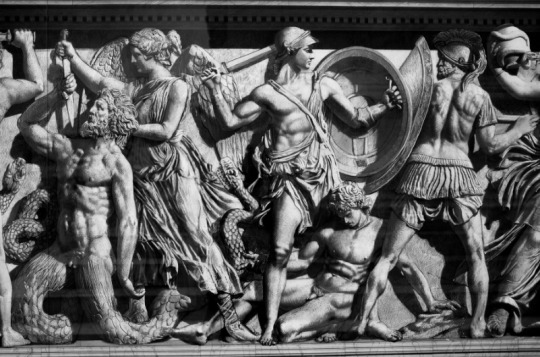#pergamon altar
Note
I haven't seen many mention it but in Germany there's this huge Pergamon Altar (Ancient Greek: Βωμός τῆς Περγάμου) in Germany , which was a monumental construction built during the reign of the Ancient Greek King Eumenes II in the first half of the 2nd century BC.
The altar is grand and huge. First how they brought it here and second why the media doesn't mention it as well to be brought back. Too huge? Okay then how about the statues of Aphrodite and Niki of Samothrace which are in Louvre? Weren't they stolen as well?
Ah yeah it is fantastic

How on earth they transferred this all the way to Germany should be the eighth wonder of the world.
I believe the reason this is not talked as much is because it raises the hard question of where it should go. It is a Greek monument but it's actual location was where modern-day Turkey is. I personally think monuments should return to the exact place of their creation.
If Turkey showed indifference to deal with it though, then it should come to Greece. And if Turkey wanted to accept it, then Greece should monitor whether it's being looked after as it should and whether the information given to visitors about it is accurate, because Turkey has this 'lil' habit of calling every Greek monument it has as "Roman" or "Anatolian", regardless of the date of creation or the inscriptions on them or any other historical record...
As for Venus de Milo and Nice of Samothrace, yes, they should be returned immediately as well and again, I think the originals should go to Milos and Samothrace respectively. Athens could have replicas I guess. I know it might not be very practical as more people would go to Athens than to the islands but what can I say, I am a romantic.
21 notes
·
View notes
Text
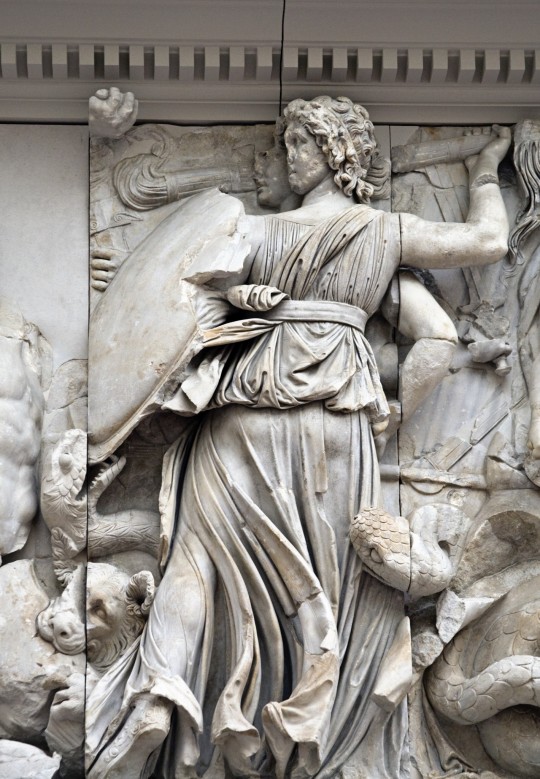
Hecate fighting in the Gigantomachy 🗡🏹
The triple bodied Titaness carries her flaming torch, a spear and sword as she engages the giant Clytios in battle. One of her dogs bites the giant on his snake leg 🏛
From the Battle of the Gods and Giants on the great altar of Zeus at Pegamon. On display in the Pergamon Museum in Berlin 🏛🏛
#hecate#titaness#triple bodied#gigantomachy#battle of gods and giants#pergamon altar#pergamon museum#berlin#bloody awesome#🏛🏛
9 notes
·
View notes
Text
The Ancient City of Pergamon in Türkiye
The Ancient City of Pergamon in Türkiye: A Timeless Marvel
Introduction
Türkiye, a land where history and heritage harmoniously coexist, beckons tourists to uncover its treasures. Among the many historical gems that grace this stunning country, the ancient city of Pergamon stands as a testament to the grandeur of antiquity. In this article, we will embark on a captivating journey to discover…

View On WordPress
#Acropolis of Pergamon#Asclepius Sanctuary#Bergama ancient city#Bergama historical site#Pergamon Altar#Pergamon ancient Greece#Pergamon archaeological discoveries#Pergamon archaeological exploration#Pergamon archaeological site#Pergamon architecture#Pergamon artifacts#Pergamon city walls#Pergamon civilization#Pergamon excavation#Pergamon Hellenistic period#Pergamon heritage#Pergamon historical significance#Pergamon history#Pergamon Library#Pergamon Museum#Pergamon Roman period#Pergamon ruins#Pergamon theater#Pergamon UNESCO#yasmin travel
2 notes
·
View notes
Photo





musée de l’anachronisme
#pop art#dark academia#museumcore#museum aesthetic#art hoe#arthoeaesthetic#taylor swift#taylor swift edit#tsedit#phoebe bridgers#ariana grande#blondie#bella thorne#zine#collage#botticelli#henri de toulouse lautrec#moulin rouge#pergamon altar#renaissance art#renaissance aesthetic#classical architecture#still life#ivan aivazovsky#jan davidsz de heem#art museum#sailorswift
1 note
·
View note
Text
The Pergamon Altar, where gods and giants come to life in stone. An awe-inspiring architectural masterpiece from the Hellenistic and Roman eras, nestled in the heart of Turkey.
28 notes
·
View notes
Text
when i was 10 years old i went with my family to the pergamon museum in berlin and i got lost cause i couldn’t stop staring at the Ishtar Gate and when they found me i got a nice ass whooping courtesy of ancient Babylon
#i will never forget#oh also the pergamon altar was real nice#thank you babylon#thank you berlin#ishtar gate
1 note
·
View note
Text
Artemis + her relationships with other Theoi 🌙🏹🦌
One of the amazing things about Lady Artemis is how versatile her domain is. Here are just some of the prominent theoi she is connected to.
Artemis + Ares 💥
- These two were celebrated together during Kharisteria/Charisteria ('thanksgiving'), which took place on the sixth day of Boedromion.
- Goats were sacrificed jointly to Artemis and Ares for their roles in battle and war.
- Even though Artemis is not technically a 'goddess of war', her role as the (sometimes brutal) hunter gave her an association with battle and death. They were also both patron deities of the Amazons.

Diana of Versailles (original attributed to Leochares)
Artemis + Apollon 🎼
- Perhaps her most famous connection is to that of her twin brother. They are opposites but are also, in a certain sense, two sides of the same coin.
- Apollon is the warmth of the sun, Artemis is the light of the moon. (They also shared the epithet 'light-bringer') They compliment each other while contrasting.
- They are day and night, city and country. They complete a cycle, making them almost inextricably interconnected in myth. Yet they also share domain over hunting, healing, death, and even music.
- The muses, who were led by Apollon, were often seen accompanying Artemis and her nymphs as she danced through the forest. Dance and music were also vitally important in her rituals.
Artemis Hymnia=Of the Hymns
Artemis Hegemone=Leader of Dance/Choir
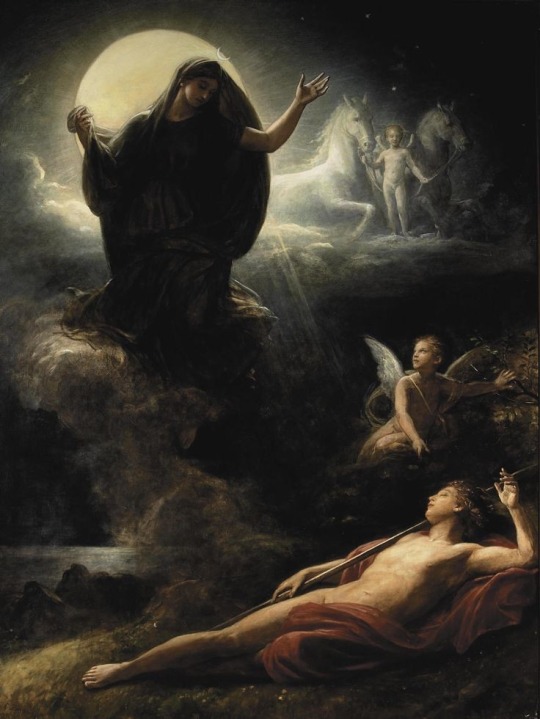
Diana awakening Apollo (Carl Bertling)
Artemis + Dionysus 🐆
- Artemis and Dionysus are both deities of the thin line between us and animals/'beasts.' They symbolize our own wild nature and what it means to succumb to it.
- They historically shared in rituals of 'frenzy', release, and estastic dance. Both are deities of revolutionary liberation and freedom.
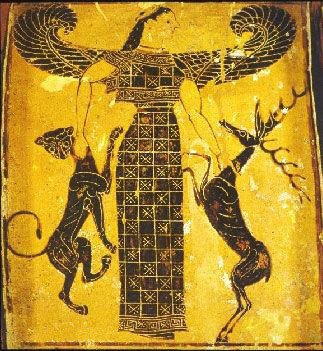
Artemis as 'Potnia Theron' on the François Vase
Artemis + Hekate 🔥
- These two goddesses are so heavily connected that many conflate/synchronize them. They are both deities associated with the night, the moon, and for their roles in protecting the young/children.
- The Roman goddess Diana Trivia is sometimes thought to be a syncretism of Luna/Selene, Artemis/Diana, and Hekate/Trivia.
- They were both known to hold torches and snakes, and some say that it was Artemis instead of Hekate who used her light to guide Demeter to Persephone during her search. Although most still contribute this part of the story to Hekate, it shows how conflated the two goddesses are.
- In some versions of their stories, Iphigenia was 'turned into' Hekate by Artemis. In others, Artemis 'became' Hekate as a companion of Persephone after her descent into the Underworld. Variations of Hekate's name were also epithets of Artemis.
Artemis Hekatê/Hekate = Far-Shooting, Shooter from Afar, or Worker from Afar
Artemis Hekatêbolos/Hecatebolus = Far-Shooting, Far-Darting, or Hundred-Shots
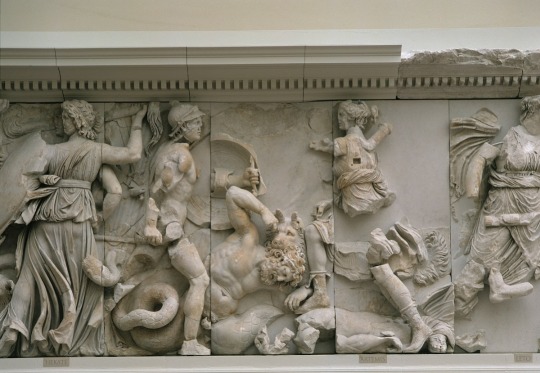
Artemis, Hekate, and Leto from the Pergamon Altar
Artemis + Persephone 🥀
- It is said that these two were raised together, perhaps with Athena, prior to her descent into the Underworld. They also share domain over nature and vegetation.
- In the Homeric Hymn II to Demeter, (and many other sources) it is said that Artemis and Persephone were picking flowers (sometimes with Athena) when she was taken.
- When Persephone returns from the Underworld, we can only assume that the two sisters and childhood friends are reunited just as she is reunited with Demeter.
- Hekate is also considered to be Persephone's companion in the Underworld. So if one syncretises the two, Artemis-Hekate would be her companion year round!

Diana's Bath (Louis Devedeux)
Artemis + Demeter 🌾
- As well as being deities of vegetation, Artemis is connected to both Persephone and Demeter in their roles in the Eleusinian Mysteries (Hekate also had a prominent role in this tradition).
- The mysterious goddess Despoine, also central to the Eleusinian Mysteries, is thought to be Persephone, Hekate, Artemis, or some syncretism of them.
- The sanctuary of Despoine, which was vital to the tradition of the Eleusinian Mysteries, was in Arcadia. At this sanctuary, Pausanias stated that multiple representations of Artemis could be found; including a 'six foot tall bronze statue' which stood guardian in front of the entrance to the mystery cult.
- A theory states that Demeter is actually the mother of Artemis, while Leto is her 'sister' or 'nurse.' Pausanias claims that "Artemis was the daughter, not of Leto but of Demeter, which is the Egyptian account."

Artemis with a Dog (Munich)
Artemis + Selene 🌕
- It is traditionly stated that Selene is the personification of the moon itself while Artemis is a goddess of the moon.
- At some point, the two were congealed/synchronized as Artemis became more and more heavily associated with the moon. The Roman goddess Diana almost certainly involved syncretism between the two.
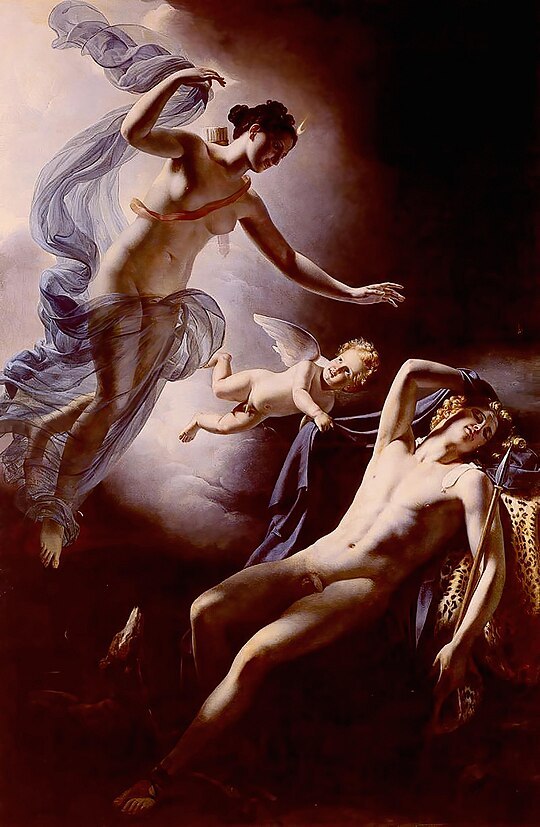
Diana and Endymion (Jérôme-Martin Langlois)
Artemis + Pan 🌿
- Artemis and Pan are both deities of the wild, pastures, woodland, animals, and the country. Rural deities with connections to dance and music, these two have a similar untamed persona.
- Pan gave Artemis a pack of seven hunting dogs as a gift, showing their companionship. Pan also famously had a love affair with Selene, so syncretism between Artemis and Selene also connects her to Pan.
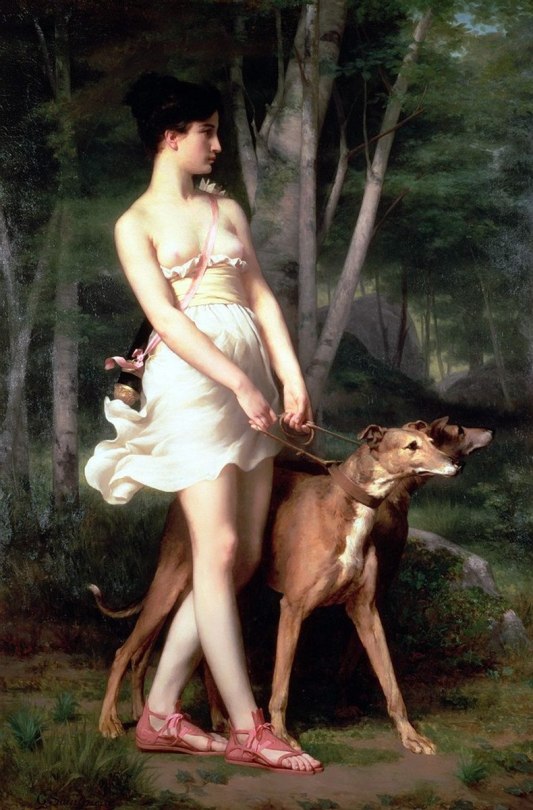
Diana the Huntress (Gaston Casimir Saint-Pierre)
Artemis + Zeus ⛈️
- Artemis has always been a favored daughter of her father. Perhaps their most famous interaction occurs from Callimachus when Artemis, still a child, presents Zeus with a list of requests - including her 'eternal virginity'.
- Zeus is happy to oblige and gives her all that she desired and more. This unconditional love and acceptance illustrates Zeus' affection for his feral daugher of the forest.
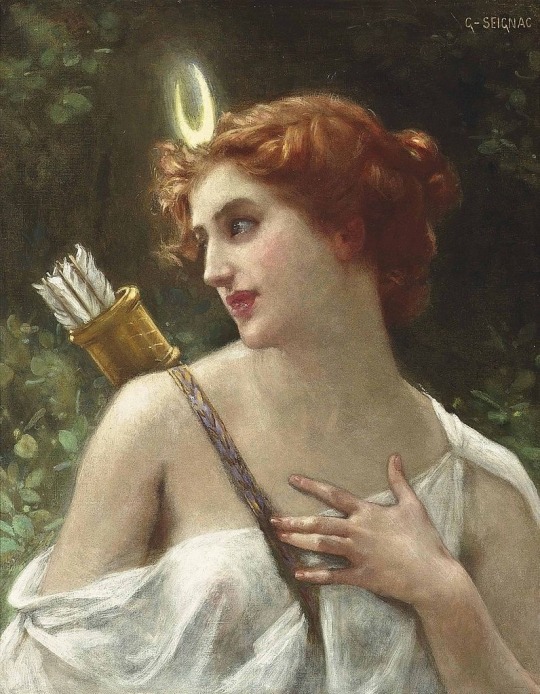
Diana the Huntress by Guilluame Seignac
Artemis + Athena 🦉
- Artemis and Athena share many similar qualities, including their 'chasity' and their choice to remain 'virgins' (in the historical sense of the word).
- As mentioned above, Persephone, Athena, and Artemis are said to have grown up together and were seen picking flowers together.
- As with Artemis' connection to Ares, Athena's domain of war, battle, and death are also connected to Artemis. Their sterness, intensity, and ability to commit violence when deemed necessary connect the two deities.

Diana as Huntress by Bernardino Cametti
Artemis + Hera 👑
- While these two were often in conflict with each other in myth, they still share connections. In historical celebration and ritual, women/girls progressing to adulthood and/or entering into marriage were ceremoniously passed from Artemis' protection to Hera's. They shared space in the context of transitions.
- In addition, Artemis has been heavily conflated with Eileithyia, a goddess of childbirth and daugher of Hera. 'Eileithyia' has even served as an epithet of Artemis.
(From The Theoi Project - theoi.com)
(From She Who Hunts: Artemis: The Goddess Who Changed the World by Carla Ionescu)
#artemis#diana#goddess artemis#artemis goddess#artemis deity#artemis devotion#artemis devotee#hecate#hekate#apollo#apollon#hera#zeus#athena#pan#pan deity#selene#selene deity#demeter#persephone#ares#hellenic pantheon#hellenic polytheism#hellenic gods#hellenic community#hellenic pagan#hellenic paganism#hellenic polytheist#hellenic worship#diana deity
315 notes
·
View notes
Text

Detail from the Pergamon Altar's frieze (The frieze depicts the Gigantomachy); built in 2nd century BCE; Today in the Pergamon Museum in Berlin.
43 notes
·
View notes
Text
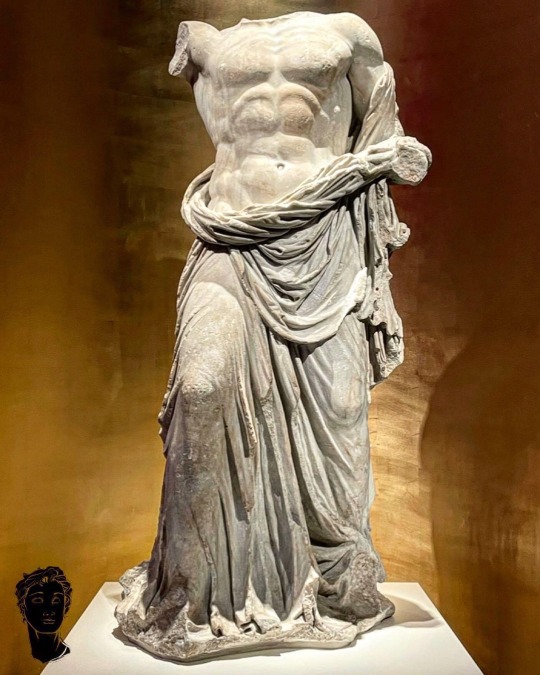
This headless marble statue comes from Pergamon and is dated between 200 and 175 BC. The figure is most likely a god and shown striking forwards in an expansive posture. His heavy cloak has slipped from his shoulder revealing a muscular torso. In motif and bodily form, the life-sized figure resembles the Zeus in the Great Frieze of the Pergamon Altar. It is conceivable that the statue depicts the father of the gods, but his identity must remain an open question since nothing is known of the lost attributes.
314 notes
·
View notes
Photo
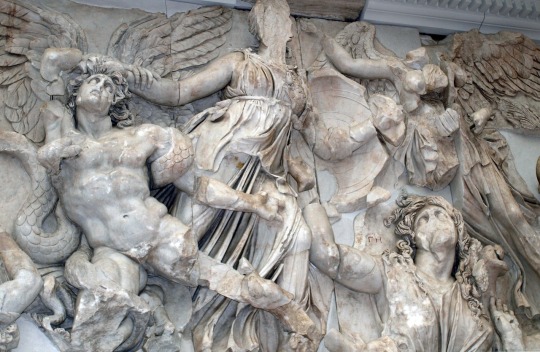
Detail of the Gigantomachy. Great Altar of Zeus, Pergamon, 2nd century BC. Now in the Pergamon Museum, Berlin.
22 notes
·
View notes
Text
Artwork showcase for Lady Asteria
I’ll keep this updated for any new or missed art and feel free to send me any art that you would like to be included! (If I’ve included your art and you wish for me to remove it please message me!)
‘Asteria Seated with Lyre’ from C5th B.C. currently in the Museum of Fine Arts, Boston

‘Asteria, Leto, Apollo’ from C5th B.C. currently in Regional Archaeological Museum Antonio Salinas, Palermo (Far right)
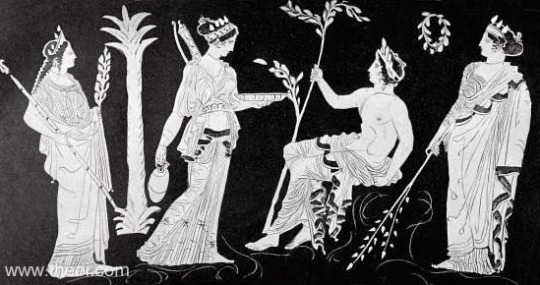
‘Pergamon Altar’ from C2nd B.C. currently in the Pergamon Museum in Berlin (Middle figure holding the torch)

‘Jupiter and Asteria’ by Marco Liberi
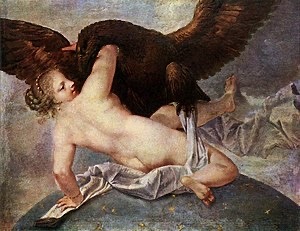
‘Asteria, titan of the falling stars and the mother of Delos’ by @pierianspring

Unnamed by Yliade

‘Asteria’ by Luisa Leal
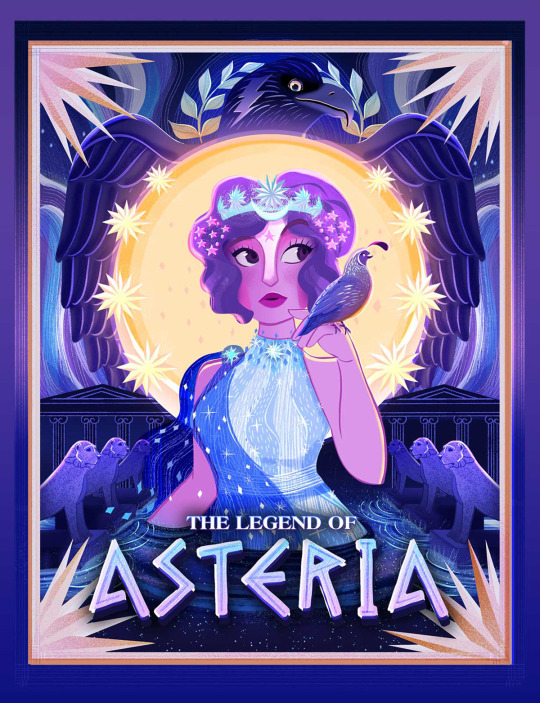
Unnamed by @dont-we-all-fall

‘We could be stars’ by @jassandbearprints
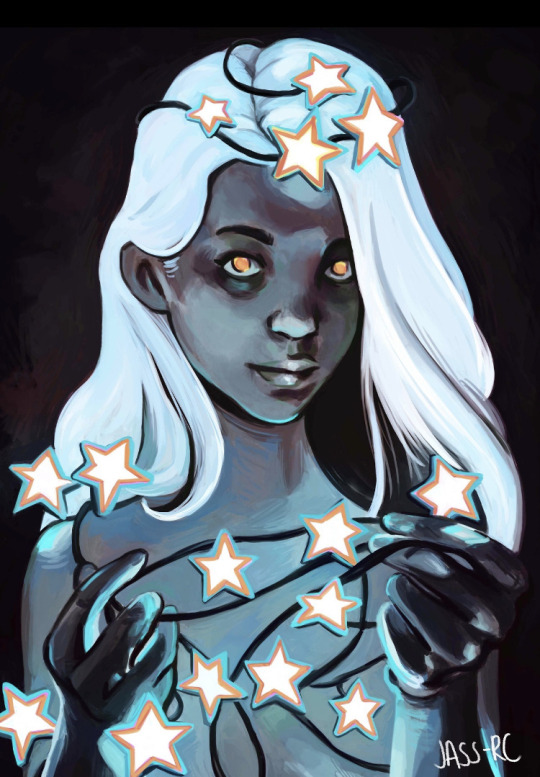
‘Quail’ by @asterias-fallen-star

#asteria#asteria worship#goddess of falling stars#hellenic deities#hellenic pagan#hellenic pantheon#hellenic polytheism#hellenic polytheist#hellenic polythiest#lady asteria#hellenic gods#hellenic devotion#art#~notable posts~
15 notes
·
View notes
Text
“God blessed them and said to them, “Be fruitful and increase in number; fill the earth and subdue it. Rule over the fish in the sea and the birds in the sky and over every living creature that moves on the ground.”
Genesis 1:27
“The devil led him up to a high place and showed him in an instant all the kingdoms of the world. And he said to him, “I will give you all their authority and splendor; it has been given to me, and I can give it to anyone I want to. If you worship me, it will all be yours.”
Luke 4:5-7
“To the angel of the church in Pergamum write:
These are the words of him who has the sharp, double-edged sword. I know where you live—where Satan has his throne. Yet you remain true to my name. You did not renounce your faith in me, not even in the days of Antipas, my faithful witness, who was put to death in your city—where Satan lives.”
Revelation 2:12-13


In summary: God gives mankind authority over the earth as his regents, mankind rebels and worships other “gods”, these gods are not imaginary but are actual created beings that have also rebelled and sought to rule the earth by convincing mankind to worship them. Their leader, known by many names including Satan, has posed as Zeus, leader of the Greek and later Roman gods, and by receiving their worship has received with it their authority. He tempts Christ with it, but He refuses.
The altar of Zeus, located in the Greek Asia Minor city of Pergamon aka Pergamum, where Christ tells John the Revelator that Satan lives and has his throne, was later excavated by archeologist Carl Humann (that’s his real name) and moved to Berlin Germany starting in 1879, partially displayed in 1901, and more fully reconstructed by 1930. These dates notably coincide with the periods leading up to two of largest wars the modern world has ever seen, periods marked by rapid advances in military technology, especially in Germany. The reconstructed temple itself would be an architectural and ideological influence for the German state, with prominent architect Wilhelm Kreis using it as inspiration for a number of projects.
6 notes
·
View notes
Text
Who Was The Goddess? Or Goddess Who? Part 3: Hecate

A goddess, probably Hecate (possibly Artemis), is depicted with a bow, a dog and twin torches.
Hi there! I'm back today with another post from the series " Who Was The Goddess? Or Goddess Who?", this series where I analyze the mythology of the Furious Hord and try to find out who was its leader and if she had any relation with the persecutions against witchcraft in the Middle and Modern Ages. And today I'm going to talk about a character that is well known: the goddess Hecate!
Hecate durig the Ancient Times
She was a goddess possibly of Middle Eastern origin, but her most widespread and worshipped version is that of the ancient Greeks, and later, of course, she was also worshipped by the Romans. And for being a very old goddess, she ended up going through some transformations throughout her history and also depending on the region where she was worshipped. According to archeological studies, everything indicates that at the beginning, she was a goddess related to the earth, the sea and the skies. Hecate, therefore, will always be closer to Artemis - both related to wild nature, beasts, fertility, and uncivilized (in the sense of unmodified by man) places.

A goddess, probably Hecate (possibly Artemis), is depicted with a bow, a dog and twin torches.
In the "Homeric Hymn to Demeter" from around 610 BC, Hacate appears as the only goddess who helps Demeter find her daughter Persephone in the Underworld. She did this by carrying torches to light the way to Hades. Because of this, Hecate became Persephone's guide every year, when the goddess returns to her May in the spring and returns to Hades in the winter. Therefore, not only did the lit torch become one of the symbols of Hecate, but it also became associated with the attribute of the key, the one that opens and leads the way, the intermediary between the spaces (physical and supernatural).

Hecate battles Clytius next to Artemis, Gigantomachy frieze, Pergamon Altar, Pergamon Museum, Berlin.
That is why it was also very common to find monuments and offerings to her at crossroads. Because of this association with the underworld, she also became associated with magic and witchcraft. If Artemis/Diana was associated with bright, full moon nights, favorable for hunting, Hecate was associated with the new moon and the darkest nights. She also came to be associated with the manipulation of herbs both to make medicines and poisons, and there she was also related to the god Helios, the Sun. The great sorceresses descended from Helios, Medea and Circe, had learned to manipulate herbs from Hecate. Although she inhabited the nether world and was sometimes represented as being able to raise the souls of the dead by making a procession of souls, she was also associated, like Artemis, as the protector of childbirth and babies. It is because of this mobility between life and death that she is often shown as a triple goddess, that is, a three-faced entity.

Gilt bronze Hekataion, 1st century CE. Musei Capitolini, Rome.
In her earliest iconography she is sometimes alone on a throne, but in later Greek images she already appears in her triple form, holding a torch, a key, a dagger, all three supported on a pillar, representing the crossroads, that is, each one looking at a different path. It is common for her to be surrounded by some animals, like snakes, birds, horses, but the animal that was really related to her were the black dogs. Although Hecate is considered a moon goddess, she was never depicted together with the moon. So if you see a statue or image of a goddess with a moon diadem, she is the other face of the satelite: Artemis and then Diana.
Hecate During the Meddle Ages
According to historian Ronald Hutton, it is very tempting to place Hecate as the leader of the Furious Hord: she was a goddess related to witchcraft and ghosts, since she was one of the guides of souls to the land of the dead and also the opposite way, she carried to earth the souls of babies that were born. Her triform image, sometimes representing 3 different goddesses: Hecate, Artemis and Persephone, or else Hecate, Artemis and Luna (all related to the moon and the underworld); or else 3 faces of the same goddess Hecate: either representing the agricultural division or even the phases of women. But for Hutton, Hecate was never depicted as a leader of spirit processions, and this also never appears in her iconography, i.e. in paintings or statues. The Furious Hord was a Germanic myth, and therefore we should look for some goddess who was more popular in that region than the Greek and Roman gods.

Please check out Hutton’s wonderfull book The Wich, it is one of the bases for my researchs!
But I wanted to show here some possibilities of a relationship with Hecate not in the Furious Hord, but in another region that from very ancient times was already well known to the Greeks: the Iberian Peninsula! And at the same time, to show how difficult it is to come to a definite conclusion when it comes to the survivals of any kind of belief.
So first; we do find references to the goddess Hecate in medieval and Renaissance texts, and perhaps the most famous of these is the goddess' appearance in Shakespeare's Macbeth. But when we look at religious texts or at legal cases against witchcraft and sorcery, the goddess is curiously absent. When they mention some pagan goddess, it is always Diana (which I even have posts about Diana here, so if you haven't seen it, go back to the feed and check it out). But then there is a doubt: did these writers know Hecate because they were erudite and studied Greek mythology but then when people went to watch the plays nobody understood who that person was but they just kept watching, or did they put these characters in the plays because they knew the audience knew them and they knew there would be an identification?

Macbeth meets the Three Witches, by John Boydell, 18th century
Another crucial aspect of the goddess are the crossroads. All over Spain, but mainly in Valencia, Catalonia, Castilla and Galicia, it is very common to see the Crosses of Ends (Cruces de Términos), these crosses here on the edge of a road or a crossroads, which were used to mark the way to a city or a pilgrimage, or the limit of a city. But there are researchers who say that they are there for a somewhat magical and macabre purpose. On the magical side, until the Middle Ages crossroads continued to serve as a place where people left offerings or made sacrifices and/or penances in search of some gift, luck, or to be healthy. On the more macabre side, in ancient times the crossroads could be used both to bury people because of their proximity to the other world, but they could also serve as a place to execute criminals for the same reason. And in the Middle Ages, this relationship continued.

Pairón in Torrubia, Guadalajara, Spain.
In Valencia, the Almassera cross, for example, is where the gallows were also placed.

Cruz de Almàssera, Valencia, Spain
In 1252, King Alfonso X the Wise forbade Jews, Moors, heretics and criminals to be buried in Christian cemeteries, so these crosses sometimes served as burial places.

If you are just like me and like to take a look at the characters even knowing that medieval ppictures are not the most acurated of them all, here it is! (And totaly unrelated, but if you like medieval chants and music, please check out those “Cantigas de Santa Maria”, one of the greatest musical productions of the Medieval Europe! Alfonso X the Wise and collaborators. Miniature of the Cantigas de Santa María.
The purpose of the crosses seems to be, besides indicating a path, to sacralize a marginal terrain. They would serve to prevent the departed soul from wandering among the living, so the cross would serve to mark that place as a consecrated resting place in some way. AND WHO WAS THE GODDESS OF THE CROSSROADS AND OF THE PATHS BETWEEN HERE AND THE OTHER SIDE? WHO WHO????
AAAHHH, so does that mean that this is proof that the cult of the goddess Hecate survived into the Middle Ages by means of the crossroads? Not exactly. As I said, this belief of the crossroads as a communication with the other side is very old and it is possible that when the Greeks, and then the Romans, arrived in Spain, they found beliefs and rituals of the Iberian Celts or the Galicians that were similar to theirs, and they ended up relating these places to places of worship of the goddess Hecate and sometimes also to the god Mercury, since he was the god of travelers.

Andrea Alciato's Liber Emblematum/Kunstbuch,Frankfurt am Main, 1566/67 Liber emblematum ... Kunstbuch* (1567), Franckfurt am Main
And then when Christianity arrived, it didn't destroy these rituals, it just modified and transformed them into something Christian. So the idea is that first there was a statue for a goddess, let's say a Celtic goddess, then there was a statue for Hecate, and now we have a cross with the image of the Virgin Mary. By the way, if there is any procession of the dead led by a "goddess" that has survived until today, it is the Holy Campaign (Santa Campana/Campanha), a retinue of spirits of the dead that travels all over Spain, Portugal (and Brazil, of course) often led by a kind of a "goddess" - the Virgin Mary herself (but this is subject for another post).

A Santa Compaña. Camilo Díaz Baliño. 1919.
Not surprisingly, the image that appears most often on those crosses of the Termino I just mentioned is that of the Virgin. It is she who now guides the souls and protects the living along the way.

Coronation of the Virgin - Monasterio de Silos. Guide to the Romanesque of the Monastery of Santo Domingo (Burgos).
#witch#witchcraft#witchcraft history#witch community#pagan#history#historian#historical#hecate#santa campana#ancient history#meddle ages
15 notes
·
View notes
Text
"Night (Greek Nux) is personified in Hesiod. She is born from Khaos along with her brother Erebos, with whom she mates and bears Ether and Day (Theogony 123–125; see also OH 5i). Night produces by means of parthenogenesis a brood of personified abstractions, notably for our collection Death, Sleep, and the race of Dreams (Theogony 211–225; cf. Hesiod also mentions Night in connection with the geography of the underworld. She owns a house, where her children Sleep and Death also live. Day lives there, too, but is never there at the same time at Night; they only greet each other as one leaves and the other returns from the world above (Theogony 744–761; cf.).
Night perhaps should be seen as belonging to a pre-Olympian generation of divinities in Homer. In the Iliad, as Hera triesto cajole Sleep into inducing Zeus to slumber, Sleep maintains his readiness to bring his gift to all gods, even Okeanos, the father of the gods (14.246, and see OH 83i), but recalls the catastrophe barely averted the last time he put Zeus to sleep against his will. At that time, he escaped the anger of Zeus by the intervention of Night (implied to be Sleep’s mother?), who is described as having power over immortals and mortals and whom Zeus is hesitant to displease (14.256–261). It is not clear what place Night has in Homer’s cosmology, but the respect and fear Zeus shows and feels toward her suggests that Homer considered her to be an old and powerful figure. This is the role she has in various Orphic theogonies, where she is considered to be among the earliest divinities. In light of the Homeric passage, it is first interesting to note that Night gives Zeus oracular advice, e.g., on how to reconstitute the world (Orphic fragment 241; cf. also 113 and 237). In the Rhapsodies there are up to three individual Nights (see West 1983, p. 70, and Betegh 2003, pp. 141–142). The first one existed before Protogonos (Orphic fragment 112–113). Another Night is the daughter of Protogonos (Orphic fragment 148), who later abdicates his throne to her in the symbolic passing of his scepter (Orphic fragment 168–171; see also OH 6i and OH 10.26+n.) She (or a third Night?) also appears as Protogonos’ lover and gives birth to Sky and Earth (Orphic fragment 149; see also OH 4i). In other theogonies similar to those ascribed to Orpheus, Night is one of the oldest, if not the oldest, beings. Mousaios puts her among Tartaros and Aer (fragment 81), while Epimenides places her alongside Aer as the two primeval beings (fragment 46). Aristotle notes that even “the ancient poets” do not claim that the primeval beings (mentioned are Night, Sky, Khaos, and Okeanos) “are king or rule,” but rather Zeus (Metaphysics 1091b4–6). He does not name names, but it is possible that for Okeanos he had Homer in mind, and for Khaos Hesiod. Night and Sky do not correspond to any known theogony, but, the fact that our collection has a hymn to Night as “mother of gods and men” followed by a hymn to Sky who is called “father of all,” suggests that perhaps there was such an Orphic theogony, now lost to us, circulating in antiquity and well known by Aristotle’s time; see OH 4i and also OH O.24, where Night is called “oldest of all.”
In terms of cultic worship, there are very few instances. Pausanias mentions an oracle of Night on the acropolis of Megara, along with a temple to Dionysos, a temple to Zeus, and a sanctuary to Aphrodite(1.40.6). Note that Night has oracular powers in the Orphic poems, as mentioned already. In Pergamon, where there was a mystery cult to Demeter, religious officials dedicated a number of altars to various gods and goddesses; one official, a hymnetria (a female singer of hymns), is attested to have dedicated an altar to Night, Rites, and Happenstance."
- The Orphic Hymns, Apostolos N. Athanassakis
8 notes
·
View notes
Note
Did Selene have a cult or is it one of the cases where she was only relevant in the myth?
The references are scattered, but they are definitely here. One of the Homeric Hymns is dedicated to her (you can read it ex. here; it alludes to a mythical episode which I have not seen anywhere else, maybe it's a local or archaic tradition, who knows; the dating of the hymn is briefly discussed here). She had an altar in the temple of Demeter in Pergamon (source), she might be present on coins from Lydia (source; but it might also be Hecate)... A problem is that there isn't really a good scholarly treatment of the matter. The closest I could find is a student paper. With no footnotes.
The name Cleopatra Selene used by a few women from the Ptolemaic dynasty is apparently theophoric. There's brief discussion of this on the last page in this article. If you have institutional access to De Gruyter, there's a bit more on that (including explicit identification as theophoric) in the new book Sculptures from Roman Syria II; there's also a truly wacky example of interpretatio there, figures interpreted as "Isis-Selene" (sic). I have 0 idea how to even process what's going on with that. Based on the context I can't even tell if it's just a modern term for an iconographic type or if there actually is an ancient textual source using that term.
Lucian of Samsosata gave us the smash hit about "another great sanctuary in Phoenicia, which the Sidonians possess. According to them, it belongs to Astarte, but I think that Astarte is Selene" - while I did not really see any recent analysis of it, it feels like a joke about interpretatio to me and does not square up with the material evidence (see here).
I would personally also assume that the fact that Herodian referred to Harran as a cult center of Selene (Greek and Roman authors persistently assumed the deity of Harran was male and this surprisingly also pops up in later Arabic sources; the only exception I found while working on a relevant paragraph for a wiki article long ago was Historia Augusta which calls the moon god of Harran "Lunus", lol) can be used to support the argument that Selene received actual cult - I am not aware of any example of interpretatio of an actively worshiped deity with an abstract personification irrelevant in cult...? Other than possibly some of Philo of Byblos' hot takes (ex. if Pontos really is a stand-in for a deity analogous to Ugaritic Yam [so far not attested in Phoenicia] and not, you know, a Greek borrowing which cannot be ruled out).
10 notes
·
View notes
